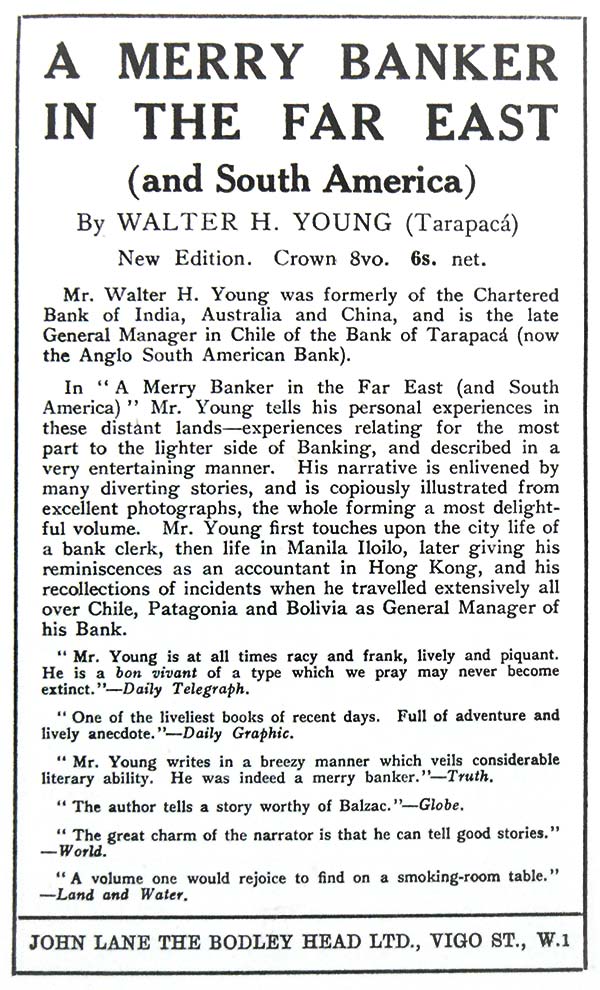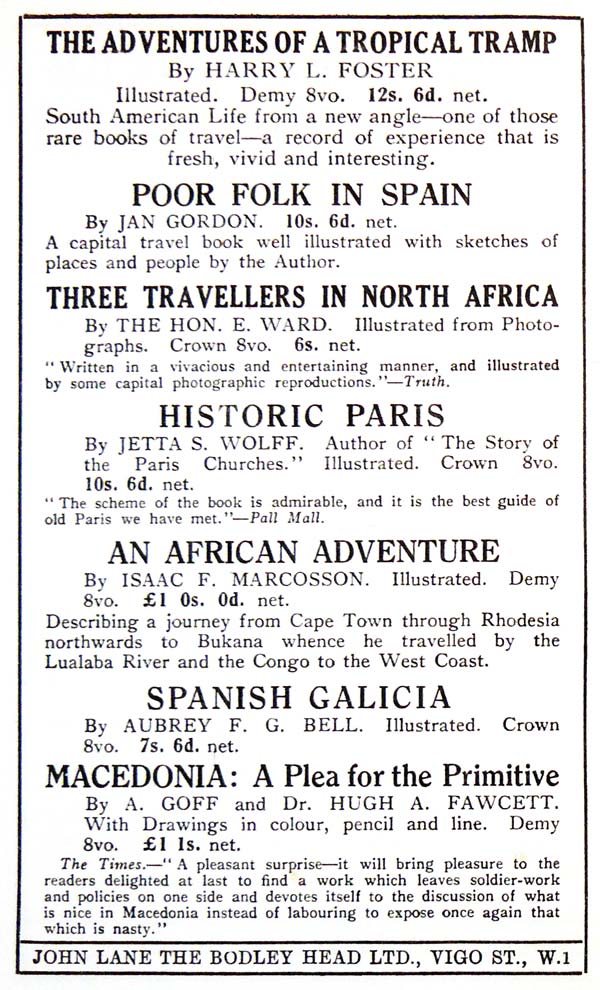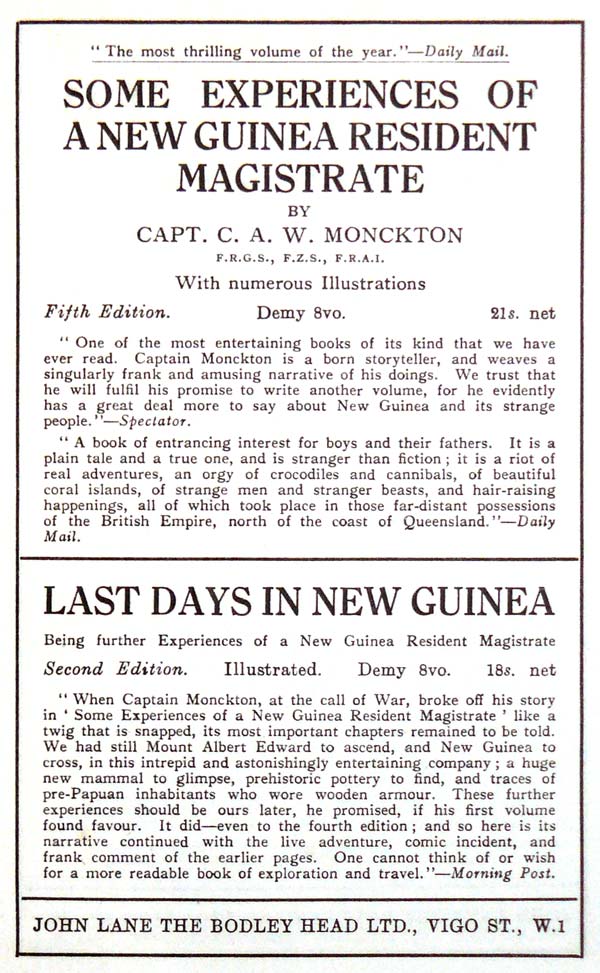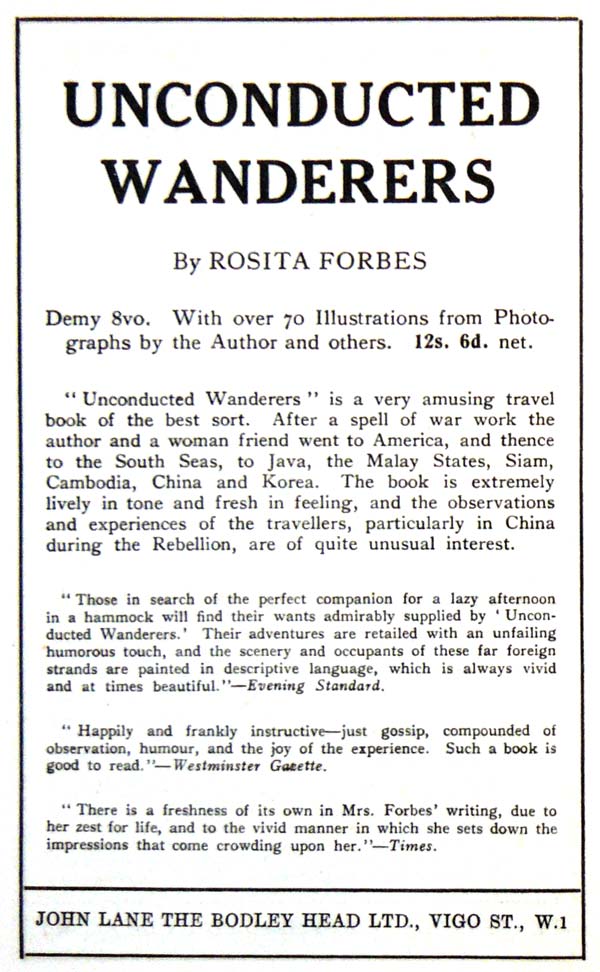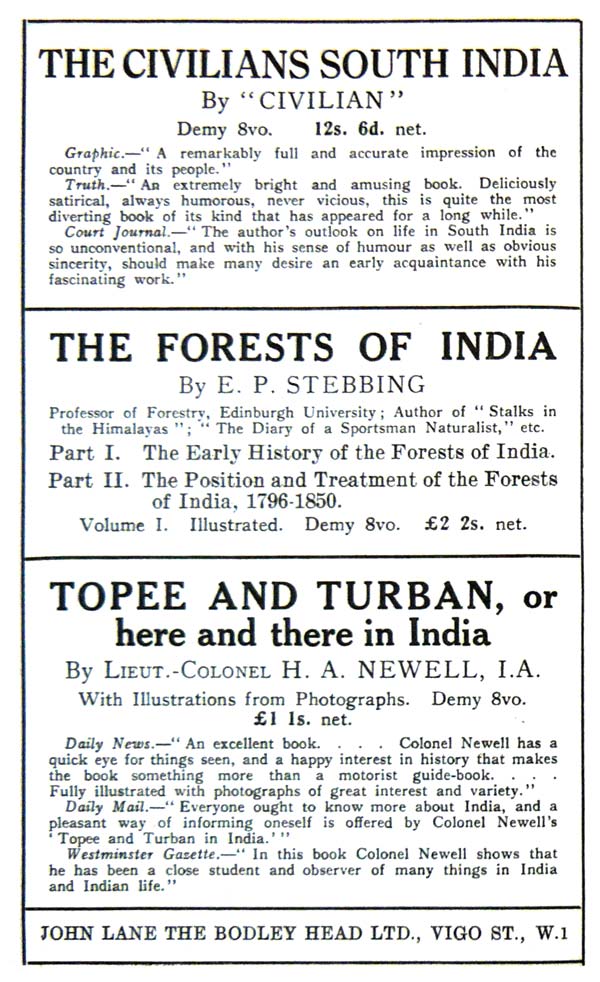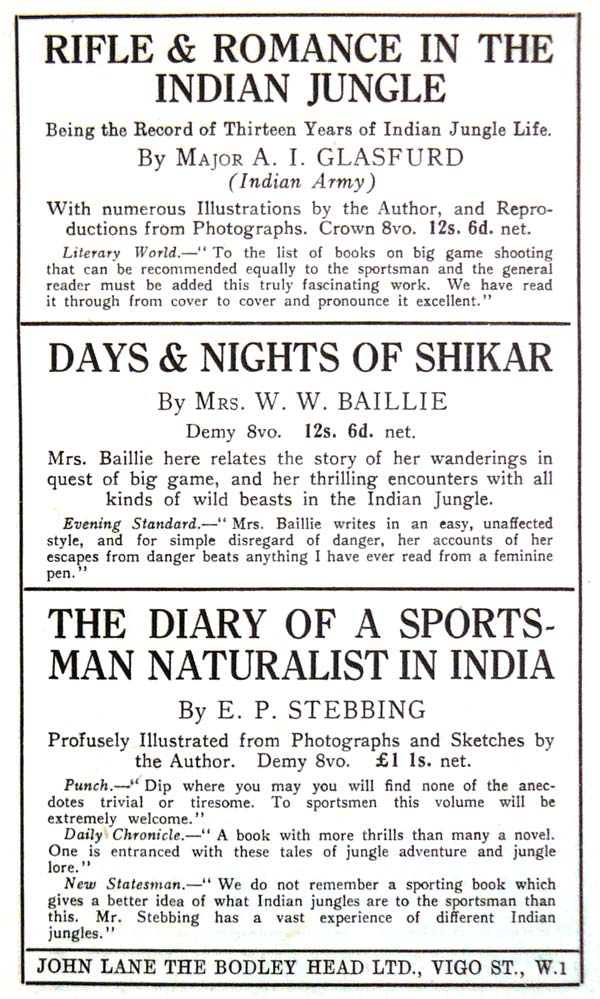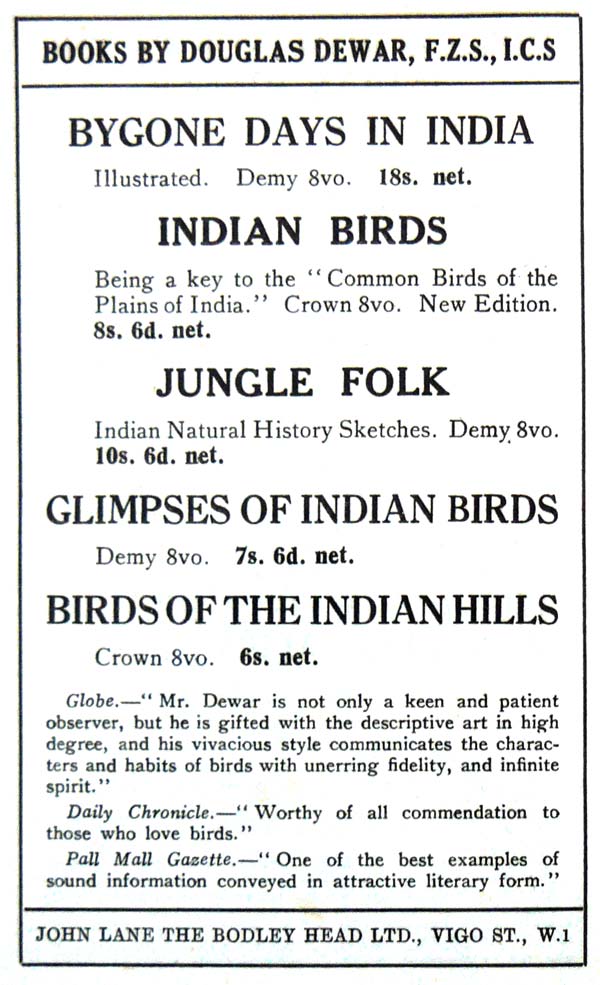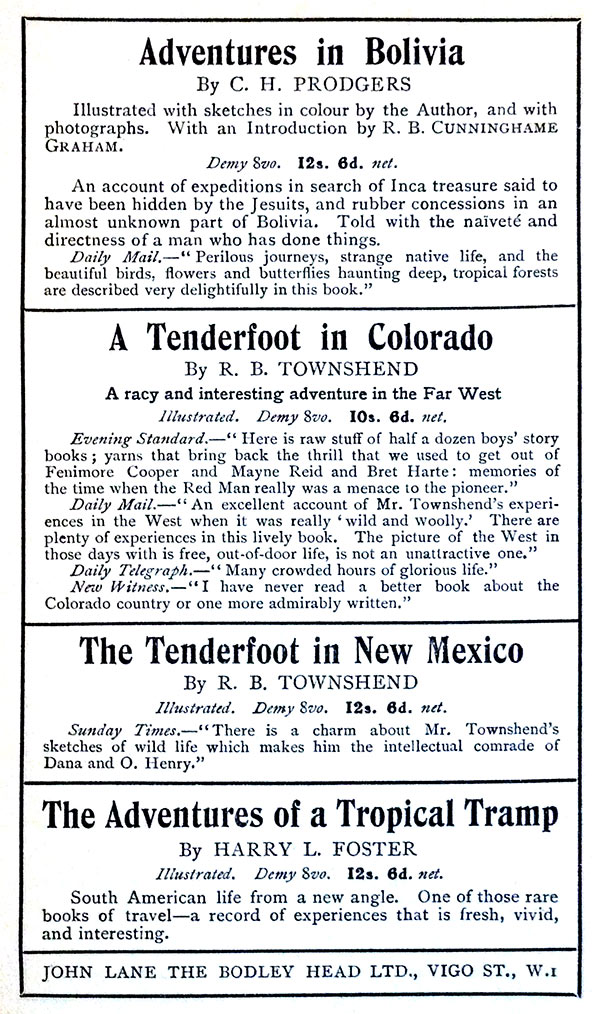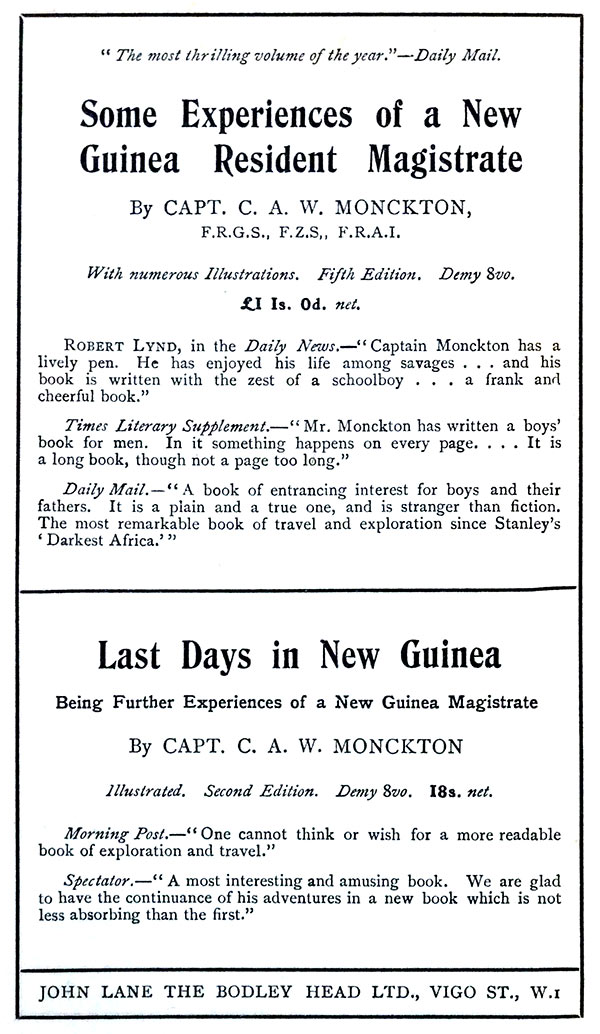More endpapers, this time from the first edition of Adventures in Bolivia.
Author Archives: Rory
A Real Bohemian
Like its predecessor, Adventures in Peru was reviewed in one or two journals of note. Here’s a contemporary review from the literary supplement of The Spectator, written by Prodgers’ friend R. Cunninghame Graham (who, as you may remember, also wrote the foreword to Adventures in Bolivia).
Adventures in Peru
Those who have read his Adventures in Bolivia require no introduction to the man. The irony of fate has cut him off with half his work undone. No one who knew him could have connected him with death, for he seemed built to set at naught the ravages of time. If he did not die, as such a man would surely have desired, in his boots, at least he left the world almost without a warning to us that he had got Blue Peter hoisted at the fore. Within three days of his death he was riding his gigantic chestnut horse (he himself weighed three and twenty stone) and having dismounted he was gone almost without farewell. He left the world the poorer by the disappearance of a type, for he was certainly an arch-type of an adventurer.
Of the same breed as Hawkins, Frobisher and Drake, he had, as Diaz del Castillo (another born adventurer), a curious felicity with his pen, not, of course, the curiosa felicitas of which Petronius speaks, but a felicity that comes from great sincerity and absence of all artifice. There are phrases in his Adventures in Bolivia that remain bitten into the mind, not bitten in with acid; no acid entered into his composition, for certainly “he was a goode Felawe” like Chaucer’s shipman; but still indelible at least to those who like the Black Douglas ever love better to hear the lark singing than the mouse squeaking.
His second book, Adventures in Peru, moves on the same lines as the first. There is still the feel of open air about it, still the same spirit of adventure and the joy of life. One feels that the writer was a man speaking to men, and not a phrase maker, with one eye on the public all the time. Such kind of books when written by a Diaz del Castillo or a Herman Melville are immortal; nothing can kill them as long as grass grows green and water runs. Both these two writers were, of course, men of genius, and genius has a lien on immortality. Prodgers falls into a different category. His “genius” was for life, not literature. All sorts and conditions of men knew him, from the President of Peru, Señor Leguia, himself a man who has had countless adventures and been in danger of his life a hundred times, to the rough sailors, herdsmen, dealers and storekeepers of whom Prodgers has left us in his two books almost as great a gallery as did George Borrow in his amazing Bible in Spain, that marvellous tale of sowing seed, so to speak, on asphalt pavement.
The second book is lacking here and there in those small touches that only the author’s hand, although a hand more used to rifle and to bridle than the pen, can give. Still it contains some curious chapters, and notably his descriptions, curiously minute, of Juan Fernandez, the island where Selkirk passed the four years that were to be immortalized in Crusoe by Defoe. Without a word of introduction Prodgers plunges into his yarn. “At the time when poor Kemmis went broke and there was nothing doing Las Rosas way, it behoved me to look round for another job.” This sentence proves to demonstration that “le style, c’est l’homme.”
To read it is to hear the author talking as he talked in life. He goes on to say: “I didn’t believe in loafing about Santiago on the chance of something turning up.” I maun premise, as Scottish theological disputants used to say, that Las Rosas is an estancia in the province of Santa Fé, in Argentina, and Santiago is a thousand miles away from it, “mile more or less,” as runs the Spanish phrase, for I believe the actual distance is not quite the thousand miles. “So I broke altogether new grounds. Hearing that Kuhn and Co. had bought the wreck of the ‘Telegraph,’ stranded at the Isle of Juan Fernandez, I got in touch with them and obtained the job of superintending her breaking up.” All this is Demosthenic in its directness. We are left without the smallest indication as to who Kuhn and Co. were. We do not want to know. All we know is that Prodgers, who had been for several years a racehorse trainer in Buenos Aires and afterwards manager of the horse ranch at Las Rosas, has now turned seafarer. Captain Brunn’s powerful tug, the ‘Pachuco,’ was commissioned for the purpose—that is, to draw the stranded ‘Telegraph’ across the hundred and sixty five miles of sea that separate the Isle of Juan Fernandez from Valparaiso, or as a friend of Prodgers used to call it “Val”!
“In addition to her own complement [number not stated in the text] she carried an auxiliary crew of eight men under Captain Brunn to man the ‘Telegraph.'” Prodgers, nothing daunted, at once assumed command and put to sea, possibly thinking that a ship is steered as easily as is a horse.
That was the way the Elizabethans, his spiritual ancestors, embarked to discover continents. They did not count the costs; no men did that. To such men adventures come as easily as coughs and colds to ordinary folk.
His description of the island reads like a page of Captain Cook. He does not launch into fine writing, describing mists with their pale opaline tints shading off into deepest orange, that again faded to a palest yellow, reminding one of the reflection on the petals of a flower cast by the iridescent wings of dragon-flies. Still, what he says accurately describes the scenery and brings it up before the reader’s eye far better than when the writer like a vulgar orator appears to listen to his own words.
What more does anybody want, unless the writer happened to be a Conrad or a Hudson, to whom nature had given so high a sense of colour and such a felicity of words ? His love of flowers is one of his chief characteristics. No matter where he is, he never fails to notice the flowers. In Juan Fernandez he remembers that the island contains “twenty five species of ferns growing in this lovely island,” and notes the Helecho fernandisciana, and the Helechos brunato and disksonia. In a journey through the desert valleys of Nasca and Cañetê he saw “a lovely bush of wild jasmine. I have never seen a bigger or finer specimen; entwined with it was a gorgeous blue convolvulus creeper. In my humble opinion nature had provided this as a protection for the beautiful bush.” The way he writes shows him to have had, in regard to flowers, something of the attitude that Hudson had to birds. Throughout his pages these references to flowers are frequent and sometimes come in almost strangely after some yarn of hunting, shooting or deals upon the stock exchange. Something there is of Borrow in his writings, especially his love for horses and in the way he loves to dwell upon good cheer. “I loaded up the cargo mules,” he says in one place, “with provisions, not forgetting to include some old Madeira, half a case of whiskey, six bottles of old port and several bottles of Liebig’s extract”—not a cargo for a trip into the interior, even for a man who weighed some twenty stone.
There is, too, something of Smollett and Fielding in his literary make-up. Not that he is ever coarse, in matters sexual, but in his intense enjoyment and delight in physical existence, a state of mind (or body) that seems nowadays to have gone quite out of fashion, or at least to be a thing to be kept in the dark. In fact, he is a real Bohemian, and a Bohemian by nature, not a person playing at Bohemia with a waiting taxi-cab to take him home when he gets bored.
Everything interests him in life, a gallop on a frosty morning on the Andean uplands, a Guanag hunt, a storm at sea, flowers, as I said before, fine horses, adventure for its own sake, and pretty girls, as when he says, speaking of some Indian women, who thought that he was mad because he took a cold bath every morning : “I could not help feeling flattered by the interest they took in me, for if the group included a sprinkling of withered old women, the majority were robust and well set up, and some of the girls very good looking.”
Nor did this joy of life exclude an interest in scientific matters, for he recalls with pride a correspondence that he had with W. H. Hudson about the Condor Real (the king of the Condors) reputed to be white. Hudson at first doubted the fact and thought the bird must have grown white with age. However, certain facts that Prodgers laid before him changed his opinion, and Prodgers says with pride, “Not long before his death, however, he was good enough to write and say … that I was right in concluding the Condor Real is a distinct species and a pure white bird.” A sportsman to the core, claiming for himself no special conscience about the matter—after the style of some who murder animals for fun or “to get specimens,” and then stand weeping tears of hogswash over their “fast glazing eyes,” he still remained humane as occasional incidents testify. Having raised his rifle to shoot at some Vicuñas, “they looked so beautiful that I felt I could not pull trigger on them.”
One thing one hopes the Recording Angel took due notice of, and blotted out some of the actions that Prodgers, like most other men, must have wished blotted out of his account. In the sympathetic memoir that his friend, Charles J. Maberly, writes of him, he refers to Prodgers’ part in helping to bring the Putumayo atrocities before the world. Prodgers himself just notices his part, in passing, saying: “I have never regretted participating in bringing them (the atrocities) to the notice of the world at large.” Further on he speaks of what went on in Putumayo as “devilish” and “cruel.”
An interesting book, discursive and written in a style that one is apt to think perished with Captain Cook and Mungo Park, but that crops up now and again and shows that the old Elizabethan never dies amongst the English race. To make the analogy complete, here and there crop up views of great simplicity, as often happens, as it seems to me, with men who spend their lives with nature cheek by jowl.
“I am much interested” (he says) “in missionary enterprise” (who would have thought it?) “and am filled with admiration of the wonderful work some of the missionaries have accomplished in various parts of the world, but I cannot shut my eyes to the fact that in South America, at least, the Gospel message seems to have had a disastrous effect on the morals of the Indians. This may, of course, be attributable to the fact that the trader with the rum-bottle follows hotfoot after the Gospel Messenger. Until the tenets of Christianity were preached to them, immorality” (he means sexual immorality) “was practically unknown among the Indians … as a Christian I cannot but feel humiliated when I think of the change that comes over some of the tribes after they have heard the Word and received it gladly.”
Neither Corporal Trim nor Uncle Toby could have bettered this delightful paragraph.
—R. B. Cunninghame Graham.
The Spectator (Literary Supplement), 4 October 1924, pp. 461-462.
So Clever and Able a Ruler
Cock-Fighting, Part 2
Peru’s supreme advantage is that she has at the head of affairs, one of the most progressive statesmen in the world, His Excellency A. B. Leguia. Backed up by singularly able colleagues, he has done great things for his country. Among the notable works accomplished, may be mentioned the settling by arbitration of the dispute with Chile over Tacna and Arica; the re-organizing of Peru’s customs and finances, so that she is now in a better position than she has ever been before; the establishment of a more powerful army and navy; and the institution of an aviation department. In connection with the last-named, an air force has been created and developed that ranks higher in efficiency than any other in S. America. There is a naval section and also a military one.
Captain John Leguia, A. B.’s eldest son, is the Director of this most important arm of the national establishment. He and James Douglas once flew to Cerro Azul from Lima and back again in four and a half hours. The distance covered was about 180 miles. Bailey, the late manager of the Cable Co., writing to the author about this feat said, “Just fancy, John Leguia, and another chap flew to the head of the Cañete valley and back in four hours! The journey used to take you three or four days on horseback.” J. L. and J. D. also flew from Lima to Truxillo. Another machine was flown from Lima to Cerro Pasco. The pilot, although flying at an altitude of 18,000 feet, carried no oxygen but simply depended on his furs.
When aviation was in its infancy, so to speak, a Peruvian named Tenaux crossed the Andes in a flying machine. He was about the first to do so. Many airmen have told me that the High Flats and the coast of Peru are particularly well suited for aviation purposes; the atmosphere is ideal, and the wind so equable.
Before President Pardo’s time, ships from all over the world used to come and load up with guano, paying the veriest trifle for it. But when Leguia took office as Pardo’s Minister of Hacienda, he put a stop to the practice. Ever since, Peru has retained this excellent product for her own use.
The Incas were well versed in agricultural chemistry, and made great use of guano, the bird manure found on the Chincha and San Lorenzo isles. They secured the preservation of the birds that supplied this valuable fertilizer, by prohibiting anyone from setting foot on these islands during the breeding season.
The police is an exceptionally well organized force. In the larger towns at night, policemen, armed with rifles, are stationed every 200 yards. Where the shops are situated, the distance between the men is reduced to 100 yards. Each man blows a whistle every ten minutes. Two blasts warn his next-door comrade on either side that the help of both is needed. Three bring up all the force available at a run. When the police call upon one to stop it is advisable to comply with their demand, for they never hesitate to use their rifles, and they shoot to kill. Periodically during the night, inspectors ride round and see that the men are at their posts. Curfew is at 9.30. People out after that hour, especially strangers, are often called upon to produce their passports.
I was made aware of this, on my first visit to Peru, in the following manner. I had with me twenty-one racehorses, two carriage horses, and an arab hack. There were eleven stablemen, some of their wives accompanying them. When we arrived at Callao and the animals had been done up for the night, I stood treat. I told the men to go and enjoy themselves, at my expense, down at the saloons, where they might hear music very well rendered by competent artists.
Next morning, when I arrived at the stables intending to exercise my horses, not a lad was visible. A policeman was there, however, and when I commented on the absence of my boys, he said, “That’s just what I have come to see you about. They are all in jail; they could produce no passports when challenged after curfew.” I at once called upon the Chief of Police. That worthy gentleman told me my people had rendered themselves liable to be fined £1 each, or sent to prison, for breaking this excellent law. I assured him they had sinned in ignorance, and that I myself was unaware of the regulation. As I had told the boys to go, I of course offered to pay their fines, and was agreeably surprised when the Chief said, “No, we won’t impose any fine this time; but in future, give your boys a scrip to say they are out with your permission.”
In Peru there is scope for millions of new comers, but no room for wasters. Pick and shovel men would be well advised to give it a wide berth, for they would only be remunerated on the same scale as the Indians, who are content to work for very small wages. The same thing applies to domestics. The poorer inhabitants of Peru make excellent servants; there are besides a large number of West Indians available.
The sort of folk Peru needs, are engineers (especially those skilled in the use of the electric drill), machinists, and capable mechanics, who are not content to loaf around in pubs, but willing to undertake jobs, and stick to them. To all such, Peru affords excellent opportunities and good pay.
To return to A. B. Leguia. Were he not so clever and able a ruler, he might easily have made a very large fortune by training and riding racehorses. He has a natural gift for that sort of thing. Few gentleman riders could hold a candle to him, and not many professionals could give him poundage. He was one of the finest light weights I have ever seen. A. B. owns and breeds some of the best racehorses in Peru, and races for the honour and glory of the sport. He often accompanies and clocks them in their fast work. As a bettor he invariably plays light. Elias’s pacers are considered the finest in the whole of Peru, but Leguia’s come second only to them, and his strain of milch cows is very highly esteemed.
In Peru—a land where big estates abound—his are among the most extensive. Coffee, sugar, cotton—they are all run on the best and most up-to-date lines. It has often been my privilege to stay at his beautiful palace, midway between Pisco and Tambo-de-Mora. It reminds me of the residence of his Grace the Bishop of Trinidad. Leguia’s father, a member of one of the oldest and most notable families in Spain, preferred his son’s house before his own. Near the palace is a nice chapel where a reverend Father attends every alternate Sunday. Close by there is the largest private swimming bath I know of.
Old Mr. Leguia died not so very long ago, full of years and honour. As his eminent son described it in felicitous phrase, “his joint oil ran out.” That was all—just simply old age. Peace to his ashes!
With this pious aspiration I must bring to a close my narrative of Peruvian incidents, and address myself to the task of recounting some of my racing experiences in Chile and the Argentine.
To those who have a fancy for engaging on a trip to Peru, whether for business or pleasure, I would offer this word of advice. Before you make a start, look up the list of things printed at the end of Adventures in Bolivia. Pretty well all you will require is there set out in detail.
Cock-Fighting
Part 1
One of Peru’s oldest and most popular sports is cock-fighting. All classes participate in this diversion. An ancient writer speaks of having been present at a main when he noted no less than eighteen ecclesiastics with fighting cocks under their arms!
On a certain occasion my friend Robert Leguia asked his brother A. B. to give me £50 to buy him a cock and two hens of the best fighting breed. I refused to take more than £30, thinking that sum quite sufficient. Subsequently I came across a book written by “The Mate” (Sir John Astley) in which the writer said he had once sent his son, who was stationed in India at the time, £50 to buy some birds for him. The youngster replied he could only obtain one bird and a few eggs for that sum. This made me feel a bit dubious as to how I should succeed. I managed, however, to buy a magnificent cock and two hens in London for £20. I had three special cases made for them, and shipped them by the Pacific Co. as far as Peru, giving the ship’s butcher £1 to look after them and keep them clean, and promising him another £1 if the birds arrived in good condition.
On the way out, the hens were good enough to lay eggs nearly every day. I used to have them for breakfast, until a lady who was frequently seasick, asked me to pass them on to her, a request I readily complied with. It is no use “setting” eggs that have been laid aboard ship, for they are not fertile.
At Valparaiso we were held up two weeks while I waited for a coast boat to take a consignment of racehorses to Peru. H. Crangle, who came aboard to meet me, was a great cock-fighter, while I, myself, had an occasional flutter, and one of my birds, trained by myself, was champion at Belgrano. Crangle thought best not to take the birds ashore, but to leave them on the Iberia until the Santiago arrived.
During the wait I experienced a stroke of bad luck. The butcher of the Iberia took some friends aboard one day, and wishing to show them a bit of sport, set my two hens at each other. They had a real good go in, and one got killed. The matter was reported to Sharp, the general manager, and also to the captain. Both were very much upset, for the Leguia family is one of the most popular in the whole of S. America. The captain put the butcher in chokey for two weeks, fined him £5, and permitted him to have only one drink a day. The punishment was none too severe, as the bird could not be replaced; but I refused to take the fiver, and asked the captain to place it in the Widows and Orphans box.
From the surviving cock and hen, Robert Leguia bred some magnificent birds, which won all the principal prizes at Lima and elsewhere. He was bid £4 apiece for the male chicks. Capital results were also obtained by crossing the cock with a good fighting hen from Panama.
Once when going home on the Pacific Royal Mail, I went ashore with a Colombian doctor at Panama and accompanied him to the French burial ground just outside the village. The caretaker was a noted breeder of fighting cocks. He sold the doctor a very good bird but not so big by half as the one I took out from England. My bird was never allowed to fight, as he weighed 9 lb. and the native cocks didn’t go much more than 5 lb.
When fighting, the birds are equipped with steel spurs about one and a half inches long and shaped like a sickle. Leguia’s birds were trained to circle round and stab once; that sufficed. As a general rule the prizes ranged from £25 to £200. At the Champion Meeting of the year—The Game-cock Carnival—held at Ica on Independence Day, the premier prize was never less than 2,000 sols. Sometimes it amounted to 4,000. There were, besides, minor awards of £35, £40, and £50.
Mains take place in Lima every alternate Thursday, from 2 to 5 o’clock. I have frequently seen several good Fathers present at these gatherings, Most of the clergy take lively interest in the sports of the people—racing, cock-fighting, bull-fighting or what not.
Fossil Fuel
Gold, Silver, Emeralds, and Pearls, Part 6
Before closing my narrative of the many fabulously rich mines of Peru and the tremendous fortunes made out of them, I ought to just mention one Dr. Neal of Iquique told me about. I refer to the great silver mine of San Pedro and San Paul. It was worked by the Incas, and after them by the Jesuits until they were turned out of Peru. Then it stood derelict for a number of years, and, as was only natural, got covered over with sand. The great earthquake of 1868 completed the bottling up process. One day an American named Chase got hold of a document that purported to give the exact locality of the long-lost mine. He was much impressed with what was set down, so went and started work at the spot indicated. He grubbed away for fourteen years, removing debris until he had exhausted all his capital. Then he appealed to his brother. But that good Christian man wasn’t “having any” as the saying goes, and made it quite clear that he was going to have no truck with any poor relations. Chase next approached a storekeeper named Harris, and here touched lucky, so was able to resume work again.
Another two years of hard graft passed, and then one day, as he was preparing dinner for himself and his two men up at his shack, one came rushing in to announce that the entrance had been at last uncovered. Chase left the dinner to cook itself, and followed the messenger hot-foot to the mine. There he feasted his eyes on a great accumulation of silver ingots which had been piled up by the Jesuits ready for removal in days of long ago. Out of this hoard he banked £700,000 within the next six months!
Soon after he was lawsuited by McKinna—a man associated with the late Colonel North in several ventures—the owner of the adjacent silver mine. McKinna claimed that what Chase had unearthed was on his (McKinna’s) property. The fight was a bitter one, but Chase won in the end, and returned to England where he bought two houses in the Cromwell Road, London, and turned them into one.
His lawyer advised him to make his will. Said he, “If you don’t, that beautiful brother of yours can step in at your death and collar the lot.” Chase was impressed and did as his legal adviser suggested; moreover, to further provide against contingencies, he married Colonel Harris’s daughter.
One day whilst staying at the Hotel Cecil, his brother, who had meantime gone broke, was announced, and Chase treated him to a dose of his own medicine. His wife bore him two daughters and then died. Chase did not long survive her. He left four millions.
Of all the copper mines of Peru, Cerro Pasco is the most famous. I have already referred to it in connection with a man named Gallo. In my opinion it doesn’t come up to the one I visited a few years ago at Chuquicamaca in the Atacama desert. Cerro Chuqui is 9,700 feet up. Some leagues away in the same province are other mountains in which Cerro San Pedro and Cerro Volcan are situated. Chuquicamaca is more like a small town than a village, what with a church, the manager’s fine house and many tenements for workmen. An American mining engineer told me the mills at Cerro Chuqui crush 17,000 tons of ore every twenty-four hours. I thought the tale a bit tall, for 7,000 tons would be pretty good work. However, there it is, as he told me.
The mountains in the vicinity of this great mine yielded me some very rich samples of silver and copper. It seems rather extraordinary to find mountains full of precious metals in the midst of a tremendous desert. But so it is.
One curious feature of this wilderness is the vast quantities of lumps of fossilized wood one meets with on all sides. Apparently they are relics of prehistoric times, and were once a kind of shrub. A great trade is done in these chunks at Antofagasta where they are used as fuel.
Some of the finest emeralds in the world are found in Peru. A few years ago a Peruvian engaged in constructing limekilns not many days’ ride from the Jura baths, struck a vein rich in emeralds. I read the full particulars of his find in a paper published only a few weeks after I had left the district. Strange to say, I had been all round there guanaco hunting. The Peruvian obtained £40,000 for his concession. I know of several localities where I believe emeralds are to be found. Those found in Peru are light green in colour—the rarest of all emeralds. They are second only to those found at Bogota in Colombia.
On several occasions I met members of the Holquin family and Mr. Ecchevaria. They were all interested in this exquisite stone. I travelled with Ecchevaria several times. The last time was on the Tagus. He then told me he had lost his emerald lode, and although he had had forty men working round for two years trying to pick it up again, success had not attended their efforts. If I would superintend the operations, he said he would be quite willing to pay me a good commission to find it, plus all the exes. attached to twenty Indian workmen. I could not, however, accept this attractive offer because I was working for Penny and Minchin at the time, and I had to convey eight horses and four mares safely to Peru.
It may not be generally known, but extremely fine pearls are found off the coast of Peru.
A Lima friend of mine once fixed up with the owner-captain of a three-masted schooner, and paid £400 towards the expenses incurred in employing divers. The venture proved eminently successful. Lots of pearls were found. One of the first little parcels forwarded to my friend by the captain, was valued at from £700 to £1200, and another lot included a pearl which was disposed of for £400.
Twisting a Peruvian
Gold, Silver, Emeralds, and Pearls, Part 5
Besides the notable mines already mentioned, particular reference to the celebrated San Domingo mine is overdue. It may be approached from Tirapata or Juliaca; in either case a three days’ journey is involved. The manager of the Inca Gold Mining Company, who now own the property, makes Tirapata his headquarters. As I have said before, San Domingo was rediscovered by Major Gibson of the English Guards. This was about 1900. Gibson was on long leave at San Francisco, where he made friends with a Jesuit Father. From him he learnt much about San Domingo—how it had been worked by the Incas, and after them by the Jesuits. To crown all, the Reverend Father had in his possession a document, in which were set down all the particulars necessary to locate the mine. This he offered Gibson, stipulating that the latter in return for it, should give him and his Order 10 per cent. of the proceeds.
Major Gibson lost no time in getting back to Peru, and following the instructions implicitly, soon came upon the mine. It was all overgrown with vegetation, but in almost as sound condition, internally, as when abandoned by the Jesuits. Old John Simpson, who in 1905 went with me to examine the Sapo mountain, accompanied Gibson, and reported on the samples he took. The latter denounced his find in the Mining Department of Peru, together with 200 hectares, as a rediscovered old mine. He then returned to England, where he hoped to induce his friends to put up the necessary funds, so that he might open out the old workings and develop them. Within a couple of years he had scraped together £5000, and returned to San Domingo, intending to commence operations without further delay. Unfortunately, he hadn’t kept his good fortune to himself, but had let his tongue wag in Arequipa and other places. Hence, when he reached the mine, he found it a busy hive of workers. On applying to Mr. Chester Brown, who was pointed out to him as the manager, the latter explained that he had been reported for not complying with the mining laws; as a consequence the mine had passed out of his control.
The man who had denounced Gibson’s lapse was directed by the authorities to advertise in any paper he liked, calling upon Gibson to appear at the Ministry of Mines Department, and show cause why he had not complied with the rules and regulations. The Peruvian took good care to advertise in an obscure little rag, called the Arequipina, which had a very limited circulation. It is true, that a copy of this paper was exhibited in the Public Court House; but none of Gibson’s friends saw it, and it was also overlooked by the British Consul, whom Gibson had asked to act as his agent. Fifteen days passed, and then as Gibson had made no sign, the mine became the property of the Peruvian. This gentleman at once put on the number of men deemed necessary by the authorities, i.e. sixty. Six months later he sold his rights to the San Domingo Company for £72,000!
As an Englishman, one cannot but sympathize with Major Gibson; at the same time, one must admit that the law he failed to observe is a just law, and wisely framed in the interests of the country. It prevents anyone from exploiting the land, and ensures that it shall not stand idle. Poor Gibson was terribly put out, over the downfall of his hopes. He started off on a shooting trip in the forests near San Domingo River, to take his mind off his woes. Unhappily, he contracted a fever and only returned home to die. I had these particulars from John Simpson, who, when reporting on my Sapo mine, said it was much richer than San Domingo. In 1921 I was told that San Domingo was re-sold a few years later for £400,000 to a big company, the Inca Gold Mining Company, as a matter of fact.
Just about the time I was at Lima, i.e. between 1900 and 1907, there was a gentleman nosing around whom I will call “Q.”, the son of a British General, and on an allowance of £400 a year. He did some prospecting, and worked for himself and others. One day he went too far. He came down to Lima, saying he had found a fabulously rich gold mine only three days from Arequipa, and showing some very fine samples. He persuaded a wealthy Peruvian to go back with him to the mine, and pointed out the lode whence he had taken the quartz. He said, “You can drill wherever you like in the lode.” The Lima man did so and found visible gold in large quantities. The Peruvian was so enamoured that he gave “Q.” a cheque for £10,000. “Q.” returned to Lima and cashed it. I was nearly the last man he saw. He declined my invitation to dinner, and offered as his excuse that he was dining with Captain Moffat on the Tu Capel.
Next evening, as I was shutting up my boxes and seeing everything was all right, the Peruvian called, accompanied by a police inspector, and asked if I had seen “Q.” lately. I said, “Yes, yesterday about 6 o’clock. He left here to go to Callao on the Tu Capel.” The inspector said, “Do you remember that mine he spoke about? He persuaded a Peruvian to give him £10,000 for it.” I replied, “He must have been a mug to part with so large a sum without calling in expert advice.” Well, the upshot was the Peruvian found “Q.” had salted the mine, i.e. fixed up samples for greenhorns to find.
I heard later that “Q.” left the steamer at Iquique. Next time I went to Peru with my annual lot of racehorses I was told “Q.’s” father had written the Peruvian, promising to pay him the sum out of which he had been swindled, on one condition, viz., that he did his best to find “Q.” and get him arrested wherever he might be. “Q.” lay low for some years in Iquique, which most folks know is in Chile. That country and Peru were then not on the best of terms, so “Q.” was safe for the time being. What became of “Q.” subsequently I don’t know. But did you ever hear of a bigger fool? Just for the sake of “twisting” the Peruvian, he risked and lost his allowance of £400 a year, forfeited what would have come to him under his father’s will and £25 a month besides, which a well-known company paid him for looking after their interests!
The Putumayo Atrocities
Gold, Silver, Emeralds, and Pearls, Part 4
Near the Pass of Aricoma several sources of the mighty Amazon rise. The mountains here run up to close on 25,000 ft. Tirapata is the rail-head of the line. The manager of the Inca Gold Mining Company resides in the hacienda below.
About three days distant by mule is the small town of Assilo, whose chief attraction is a wonderful old church built by Padre Valverde, first Bishop of Peru. It was this gentleman who christened Atahualpa. The Inca Chief, so the tale runs, was led out of his prison at Caxamarca on August 29 1533, chained hand and foot, and attended by Valverde. The latter persuaded him to adopt the religion of his conquerors and so escape the burning at the stake, for which the more merciful method of the garotte would be substituted. Atahualpa was baptized Juan de Atahualpa, Juan being in honour of John the Baptist, on whose day the ceremony took place.
It is said Pizarro was greatly affected, and tried to have the venue of the trial altered to Spain. The most important charges levied against Atahualpa were, that he had murdered his brother Huascar, and had incited the Indians to resist the Spaniards. Pizarro and D’Almagro, who sat in judgment on him, sentenced him to death. Valverde, amongst others, signed the death warrant, and declared Atahualpa deserved his fate.
Taking into consideration the upbringing of Atahualpa’s judges, and the enormous ransom imposed, one is at liberty to doubt whether Pizarro’s emotion was feigned or not. The sentence was duly executed and announced by trumpeters in the grand square. Atahualpa’s remains were interred in the cemetery of San Francisco, but after the Spanish yoke was thrown off they were removed to Quito, in accordance with his last wishes. I visited the jail chapel at Caxamarca, and was shown the altar, which now occupies the site of the stone upon which the unfortunate Inca was strangled.
It is generally believed that the reason why the Spaniards broke faith with Atahualpa was, they felt sure they would never conquer the country while he lived. The news of his foul murder was conveyed throughout the length and breadth’ of the land, by means of whistles and other Indian methods of signalling. When it reached the ears of the natives, who were on the way to fulfil their obligations, they hid much of the treasure which they had collected, and the remainder they threw into one or other of the sacred lakes—Titicaca, Orces near Cuzco, or the little one near the top of Sorata.
Lake Aricoma occurs between two ranges of the Andes, and is remarkable as being one of the highest lakes in the world. The sight of this vast body of water at so tremendous an altitude fills one with awe.
The terrible atrocities perpetrated at Putumayo have not yet died out of people’s memories. I have never regretted participating in bringing them to the notice of the world at large. I had first-hand information from Daniel Wheeler, who was employed by Barber and Co. of Cochabamba. He threw up a £60 a month job and returned to Cochabamba, because he couldn’t stand the devilish, cruel methods of the overseers. I had opened out to Barber, when I was dining with him, and had told him the money he was making was all blood money. He wouldn’t believe what I told him, but said, if it proved to be correct, he would chuck the business altogether. He had, some time previously, announced his intention of retiring directly rubber fell to 5s. per lb.
During the period covered by these outrages, viz., from 1905 to 1907, a man named O’Donnell killed an Indian, so that he might abduct his wife. The woman would, however, have nothing to do with him. On the contrary, she reported the murderer to the Peruvian Government. O’Donnell took fright, and ran away to Barbados. The Peruvian Government asked for his extradition after the woman had been sent out to identify him. This the British Government granted, and O’Donnell was tried for his life. He escaped the consequences of his dastardly deed, however, through the wiles of his advocate, a man named Reece. This worthy contended that the documents were not in order, and therefore the Chief Justice had no jurisdiction, pointing out that no signature was attached to them, but only a rubric. His Honour asked the meaning of the term, but no one seemed able to tell him; so O’Donnell was set at liberty. The same day he took steamer to Brazil leaving his wife, who was the daughter of a prominent official, behind him. O’Donnell, I may say, owned the Hotel Amazon. Next day Dr. Messiah, a retired Government medico, asked me if I knew what a rubric was. I explained that although it was quite true no document in Peru and Bolivia is valid unless it is signed by a court official, yet, in the case of a high official, all that was required was his initials round the coat of arms, accompanied by a certain flourish. Now the O’Donnell particulars were thus inscribed, and were, therefore, perfectly in order. Some weeks after, an escort of Peruvian soldiers arrived to take O’Donnell back to Lima. Through the silly misunderstanding over the rubric, they had their journey for nothing. When the full facts came to the knowledge of the authorities, an order was issued for O’Donnell’s arrest in any part of the world where a British Consul held office. Upon this O’Donnell cleared out of Brazil, and fled to Venezuela.
During his detention at Barbados, at least three other prominent overseers sought sanctuary elsewhere, expecting, doubtless, that their turn would come next. This matter of the Putumayo atrocities was very thoroughly taken up by the British and Peruvian Governments. Ultimately the company went into liquidation and was broken up.
A String on the Toe
Gold, Silver, Emeralds, and Pearls, Part 3
Ayacucho, one of the most ancient cities of Peru, is noted for its jewellers and fine silver-smiths. These craftsmen hold closely to the traditions handed down by their forefathers, and turn out work that is worthy of comparison with that of Inca days. Altogether there are about seventy of these art workers located in or around Ayacucho. I have compared specimens of their handiwork with ancient filigree ornaments unearthed at Pachacamaca and Tia Huanaca, and can distinguish very little falling off in design or execution. Lord Brassey, when he visited Peru on his yacht, the Sunbeam, in company with Lady Brassey, sent an emissary to purchase jewellery here. I’m told he laid out £5000.
Ayacucho also used to be noted for its white alpaca, and vicuña carosses, or rugs. A great many ruins, Inca and Huanca, and twenty-four churches, testify to its importance in days gone by.
There are two ways of getting to this fascinating place. My favourite route is by way of Pisco, Ica, and Huancavilla, muling it all the way, in the finest atmosphere in the world and through some of the sublimest scenery. The easiest way to Ayacucho is to rail it from Lima to Huancayo (10,000 ft.). That takes two days more or less. The remainder of the journey occupies three or four days on mule-back.
Among the many rich gold mines in Peru, Amanca (17,000 ft.) is notable as being the highest in the world, worked by the hydraulic method. Men working and prospecting in the neighbourhood, showed me lots of quartz with traces of gold in it. I sent samples to M. M. Penny, but just then he was all for tin, so there was nothing doing. The conduits and sluices here were constructed of stone when the Spaniards governed the country. At that time much gold was washed out and sent to Spain by the Viceroy, who had 6000 men employed, washing and digging out gravel. Further on, the Poto River runs through soil that is very auriferous.
In dealing with Indians one has to be careful, for some of them are not above mixing particles of brass with the gold dust. Round about Limbani Indian labour is plentiful and cheap. The men will show one all the likely places, and work for 4s. per day, out of which 2s. is deducted by the employer for the food consumed (mostly Irish stew) and for other incidental expenses.
To get to Amanca one has to leave the train at Crucero Alto (14,666 ft.), on the Arequipa-Puno line; and travel thence on mule-back over the High Plateau. Here sheep and llama are very plentiful. A man I knew, of the name of Creighton, once visited this place, staying with the son of a wealthy man, who had been sent there out of the way by his father, to avoid the consequences of having accidentally killed a man in a brawl. One can also reach this place from Tirapata (12,731 ft.), using mules as the media.
The Indians secure gold by laying a floor of loose stone edgeways. This they flood, and then wash out the gravelly deposit left by the water. I prefer my own method of dealing with the gravel. I used to pan it out in a basin with a little quicksilver. Whatever sticks to that is pure gold.
When I was on my way home to visit my people, and see Mariano Penny at his residence in Aberdeenshire, a Scot gave me some rich samples, which he had taken from the Amanca mine. I tried to induce Penny to let me put in a season with Creighton at Amanca, but found him more enamoured of tin than ever. About this time it had appreciated in value a good deal, hence, I suppose, he thought it more profitable to send me to locate mines in Bolivia.
At Poto, according to Creighton, the thermometer often registers 104 degrees in the sun and 37 in the shade. I can quite believe that. As a matter of fact, at the foot of the Cerro Volcan and Cerro San Pedro in the Great Atacama desert, the markings, for ten consecutive days, ranged from 80 to 83 degrees in the sun, and from 30 to 40 in the shade. I used to attach a string to a toe of my Indian servant, so that I might rouse him at 7 a.m., and I generally found the temperature then well below zero. One of the inspectors of the Antofagasta and Bolivia line said I was lucky, as six weeks before I arrived upon the scene, the temperature at 7 a.m. was 16 degrees below zero, and so continued at that hour for fifteen days on end. I was jolly glad to have avoided that experience.
A Nice Little Smack in the Eye
Gold, Silver, Emeralds, and Pearls, Part 2
At Caxamarca, in 1921, I met two Italians who had an experience that should act as a sufficient warning to other treasure hunters. Two years previous to the Great War, as they were working on the tunnel of an old mine that had been lost to sight for many years, they came across a big slab; this, when lifted up, disclosed an iron box which contained an old document. After describing a Conventille not far from where the Italians were working, it continued, “If you dig at the place indicated, you will find, about five feet down, the stone roof of a big cellar. Raise the slabs in the left-hand corner; you will then see a stone stairway. At the bottom there is rich treasure of gold and silver and precious stones.”
The Italians followed the instructions to the letter, and had reached the stairway, when one of the ten Indians they had engaged to assist them, raised the alarm. A squadron of cavalry could be seen topping the horizon! Hastily covering up their excavations, the treasure seekers prepared to make themselves scarce; but were intercepted by the Prefect of the district, who demanded to see the authority under which they pursued their inquiries. Of course none was forthcoming; so they were ordered to clear off. Being in a mortal funk, they obeyed the Prefect’s imperious command, with as little delay as possible. Six months later, when they thought the affair had blown over, they sneaked back again, intending to make a fresh start. Hard lines! They found the Prefect had been busy in the interim, and had unearthed a vast amount of treasure! This would have benefited the Italians, had they but given the usual notice to the Government.
In 1921 the Italians revisited the spot, intending to comply with all the rules and regulations. Alas! they found the Prefect had done his work so effectually that there was nothing left for them. I met them both coming and going, and they told me they had to be content with the £3000 they got for the old mine they had discovered. Even so, they came out better than I did over the old Cheeta mine which I rediscovered in the San Juan province of the Argentine. I was reported and denounced for not complying with the mining laws of the Argentine. Instead of having my full complement of men I had only a caretaker. The man who denounced me put on forty men. Six months later he sold the mine for £7000 cash, his dump and 4 per cent. of the profits resulting from the four years next ensuing, while I got nothing! What our friends across the Channel would call a nice little smack in the eye.
On the Oroya line is a place called Chusica. For hundreds of years it has been in favour as a resort for persons suffering from pulmonary complaints. It is claimed that the beautiful atmosphere will cure consumption if not too far advanced. Bronchial subjects also find it very beneficial. Besides other game, a few deer can be got here. Conspicuous amongst the many lovely flowers that run riot are the various species of Giant Cacti, whose magnificent blooms, as kaleidoscopic as a rainbow, present an unforgettable tableau.
From Chusica the line mounts higher and higher, until Monte Meggs is reached at an altitude of 15,666 ft. John Meggs, after whom the place is named, constructed the line, which includes the Galera tunnel, one of the most remarkable tunnels in the world, and the highest. It is considerably over 17,000 ft. above the level of the sea. On the way up, the train winds round and round, so that the engine may be seen rounding one bend whilst the tail end is negotiating another. When I travelled by it, the conductor, an old Scotsman, always allowed me to change into my winter clothes in his compartment. After passing Monte Meggs, the line begins to fall away, until it pulls up at Oreya (12,178 ft.), 136 miles from Lima.
I used to know Willie Meggs, Meggs’ eldest son, very well, for I had to do with some of his race-horses in Buenos Ayres. Willie and his father once had a few words about money matters. The old man said he could be either junior partner of the firm, or take £10,000 and clear out. Willie chose the alternative, and bought some race-horses. Amongst others he secured Arundel, whose English form was pretty good, for 2600 guineas off G. Haughton. Altogether he laid out a lot of money. But there was one thing he omitted to do: he didn’t renew his stock from time to time, hence it deteriorated, and after awhile became quite groggy, and he with it. One day his charming wife said to him, “Will, you owe a lot of money. What have you in your pockets?” “Twenty-five dollars,” he replied. “Let me have twenty, and I’ll see what I can do with them.” “Right-o,” said Will. Mrs. Meggs purchased two lottery tickets with the money, one for Meggs and one for herself. That was on the Tuesday. Next day but one, just as they were sitting down to dinner, along came a wire informing Meggs that his ticket had won the premier prize of £5000! Will received the good news very coolly; almost as if the winning of a great prize were of but little importance to him. I tried to persuade him to place £4000 in the London and River Plate Bank, on deposit, pay his debts out of the remaining £1000, and with what was left over, purchase a couple of infirm, good-class race-horses. I offered to train them for him, so that we might both make a bit. I’m sorry to say, however, that Will wouldn’t listen to me, but put the whole £5000 to current account; and when I last had news of him he was as hard up as ever.

